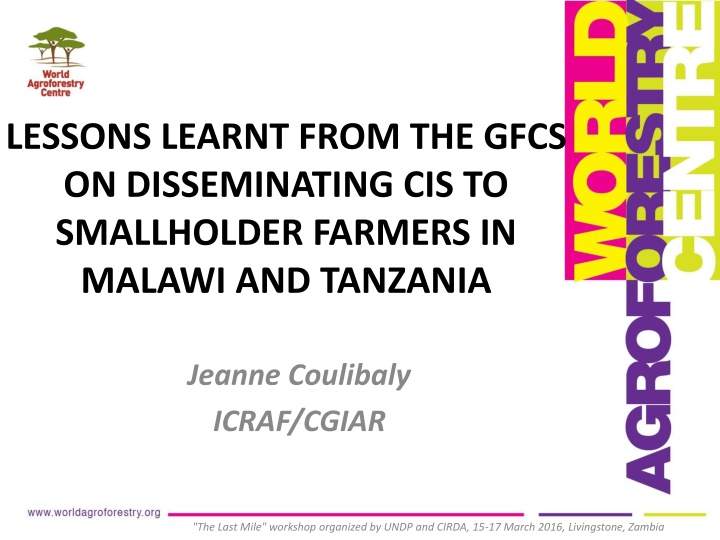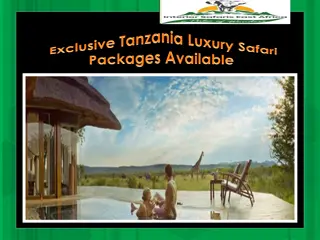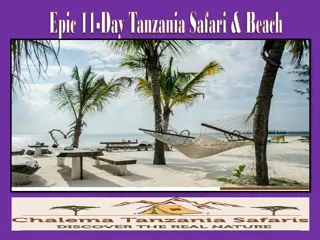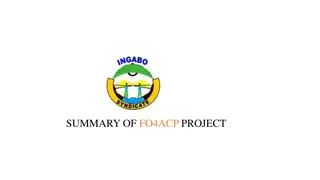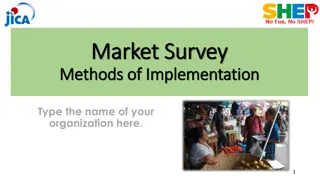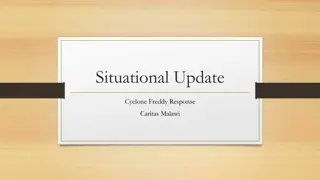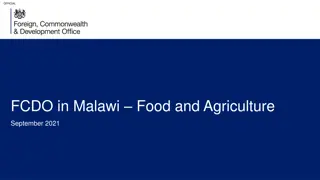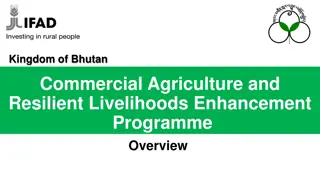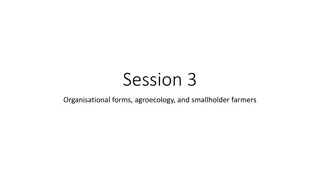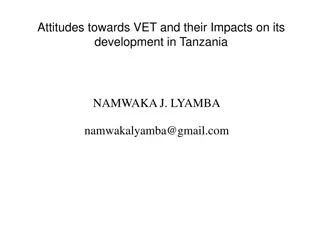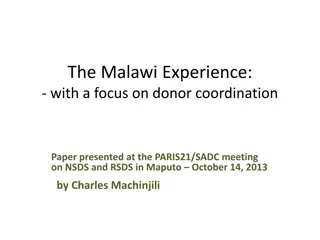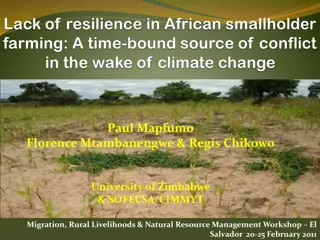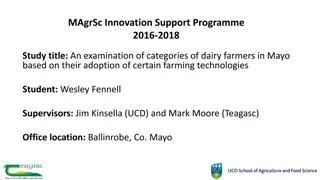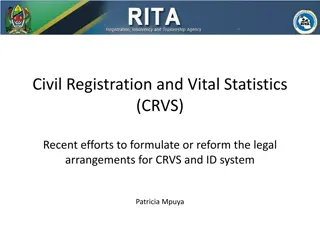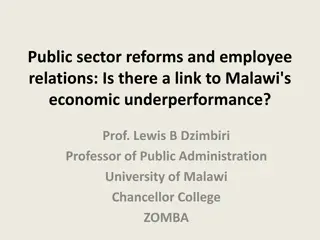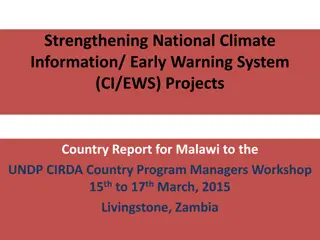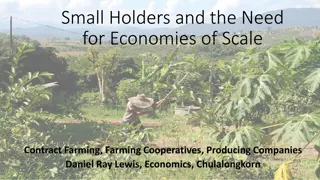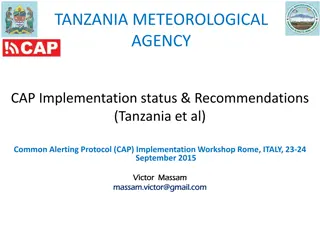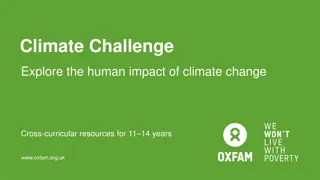Enhancing Climate Information Dissemination to Smallholder Farmers in Malawi and Tanzania
Lessons learned from the Global Framework for Climate Services (GFCS) on disseminating Climate Information Services (CIS) to smallholder farmers in Malawi and Tanzania highlighted the importance of multi-stakeholder partnerships in improving access to climate information. The advantages include a holistic approach, enhanced capacity, improved risk management, and addressing various community challenges. Challenges include the need for strong communication and alignment of activities. Lessons on needs assessment and types of information farmers rely on were also shared.
Download Presentation

Please find below an Image/Link to download the presentation.
The content on the website is provided AS IS for your information and personal use only. It may not be sold, licensed, or shared on other websites without obtaining consent from the author.If you encounter any issues during the download, it is possible that the publisher has removed the file from their server.
You are allowed to download the files provided on this website for personal or commercial use, subject to the condition that they are used lawfully. All files are the property of their respective owners.
The content on the website is provided AS IS for your information and personal use only. It may not be sold, licensed, or shared on other websites without obtaining consent from the author.
E N D
Presentation Transcript
LESSONS LEARNT FROM THE GFCS ON DISSEMINATING CIS TO SMALLHOLDER FARMERS IN MALAWI AND TANZANIA Jeanne Coulibaly ICRAF/CGIAR "The Last Mile" workshop organized by UNDP and CIRDA, 15-17 March 2016, Livingstone, Zambia
GFCS : Global Framework for Climate Services World Meteorological Organization (WMO) World Food Programme (W\FP) CGIAR Research Program on Agriculture, Climate Change and Food Security (CCAFS) Food security Nutrition World Health Organization (WHO) Red Cross Health Disaster risk reduction Center for International Climate and Environmental Research (CICERO) Most vulnerable populations National Hydro- Meteorological Services (NHMS) Department of Disaster Management and Adminsitration Ministry of Agriculture Increase the resilience of people most vulnerable to the impacts of weather and climate-related events
Advantages and disadvantages of forming multi-stakeholder partnership Advantages: Holistic approach to the production and delivery of climate information Enhance weak capacities of some national partners Improved management of risk and better provision of climate services Address the numerous of challenges that communities are confronted with: food security, health, sanitation Greater impact and sustainability in the outcomes and higher chances of achieving long term goal Challenges Strong communication to make sure activities are well integrated and connected Approaches to implement the activities and reach the goal may diverge Success of one activity may be linked to the success of other activities
Lessons learned on improving the dissemination of climate information Needs assessment to establish what farmers want and need Presents some results of the needs assessment
Types of information farmers rely to make their farm decisions Harvest time Fertilizer application Types of agricultural information Weeding time Longido Planting time Ploughing time Land allocation Crop to plant Land preparation Harvest time Fertilizer application Weeding time Planting time Kiteto Ploughing time Land allocation Crop to plant Land preparation 0% 10% 20% 30% 40% 50% 60% 70% 80% 90% 100% Percent of households Indigenous knowledge/observation Personal experience Traditional calendar Experience from other farmers Expert advice Climate/weather forecast Results of the baseline survey in Tanzania (Coulibaly et al., 2015)
Current climate information received by farmers 50% 45% percentage of households 40% 35% 30% 25% 20% 15% 10% 5% 0% Forecast of an extreme event Forecast of the start of the rains Forecast of the rains for the 2- 3 months Forecast of the weather for today Forecast for parasites or plant/animal diseases Forecast of an extreme event Forecast of the start of the rains Forecast of the rains for the 2- 3 months Forecast of the weather for today Forecast for parasites or plant/animal diseases Kiteto Longido Male Female
Most preferred types of information 100% 90% 80% percentage of households 70% 60% 50% 40% 30% 20% 10% 0% Male Female Male Female Kiteto Longido Forecast of expected rainfall over the season Forecast of the start of the rains Forecast on end of rainy season Number of days of rainfall Probability of extreme events
Lead time: Timely 100% 90% 80% 70% Percentage of households 60% 50% 40% 30% 20% 10% 0% Male Female Male Female Kiteto Longido A the beginning of the season A month before forecasting event A week before forecasting event As soon as forecasters know
Format 100% 90% Village elder 80% Village communicator 70% Advertisment percentage of households Newspaper 60% Word of mouth 50% Visit from NGO 40% Extension agents visits 30% Tv programme Radio message 20% Voice message in cellphone 10% Sms in cellphone 0% Male Female Male Female Kiteto Longido
Ways to improve delivery of climate information 100% Training of villagers on climate information 90% 80% Use of local languages percentage of households 70% 60% Extension agents specialized in weather information 50% 40% Installation of local weather stations in villages 30% Establishment of reliable communication network 20% 10% Brochures/Posters 0% Kiteto Longido
Lessons learned on improving the dissemination of climate information Carry out a needs assessment Co-production of Climate information Mixed delivery method including radio, mobile, extension workers and village leaders was recognized Timeliness in climate information Build trust and greater understanding of scientific climate forecasts Climate forecast overlay with agricultural extension advice Location specific climate forecasts Use of local languages Traditional indicators should be valued and integrated to the conventional scientific climate information
Challenges and potential ways to respond to Farmers needs Challenges: Human resource capacity still low Lack of funds and equipment Financial resources needed Private sector representation limited Coordinated efforts from important stakeholders: CGIAR, NGOs, Ministry of Agriculture, National Meteorological Services, private sector (radio, cell phone operators, etc), academic institutions
Coordinated efforts from Stakeholders Training and capacity building Modeling tools and techniques to downscale climate information Exchange of data, improvement in the availability of high quality , high resolution , satellite data Nat Hydro- Met Services Radio and mobile based interventions Train radio presenters in understanding the concept of climate change and CIS Provide them with the right information content(forecast and adaptation options) Coordinated efforts from important stakeholders to support local partners Training in communicating climate information, agronomic information on frequent basis Extension workers /lead farmers ICT related services
